The National Research Council of the National Academy of Sciences held two days of discussions this week on the controversial issue of crop biotechnology as it collects information for a spring 2016 report. [View two days of presentations and discussions]
Below are the remarks on September 16 from one of the invitees, Jon Entine of the GLP. [View Jon Entine presentation]
I’m Jon Entine, executive director of the Genetic Literacy Project. We are a non-profit NGO. We receive no industry funding. We welcome writing contributions from anyone from any ideological perspective—supportive of or critical of human or agricultural genetics—including everyone on this panel and those testifying over these two days. I am also a Senior Fellow at the World Food Center’s Institute for Food and Agricultural Literacy at the University of California-Davis.
Agricultural biotechnology is an important and evolving issue. I am not a scientist; I’m a science journalist dedicated to analyzing the politicization of biotechnology. I’ve written three books on genetics and more than a thousand articles, including in peer review journals.
I’m going to use the term “GMO” in this talk but want to make an important point: ‘Genetically modified organism’ is a meaningless term. GM is a process. Each GM crop is unique. You cannot group nutritionally enhanced Golden Rice with herbicide tolerant corn: Different crop, different trait, different consumer.
There exists a range of viewpoints about whether genetic engineering promotes deleterious farming and ecological practices—the so-called dangers of corporate controlled industrial agriculture; or the over-production of commodity crops that some say contribute to our collective weight problem. Those are important issues; they just don’t apply specifically to GMOs.
The central issue that you must assess is the safety of GM foods. Hopefully you will focus not just on specific facts, but also on the process of science:
- Reproducibility of studies
- Skepticism of one-off research
- Weight of evidence
- Willingness to revise theories in the light of new, reproducible data
In that context, many of those who maintain that GMOs are potentially harmful, while sincere for the most part, are engaging not in science but in politics. Let me give you an example. Anti-GMO NGOs often claim that the safety of genetically engineered foods cannot be assured because Big Ag funds most GMO research and there have been almost no long-term safety studies. On its website, the Union of Concerned Scientists claims: “It is … an exaggeration … to state that there are no health risks associated with GE. … not enough is known; research on the effects of specific genes has been limited—and tightly controlled by the industry.
That is just wrong.
Biology Fortified’s GENERA database lists more than 1,000 studies with another 1,300 or so to add. GM crops have been investigated for more than 20 years. There are nuances in conclusions, but the evidence is consistent whether the study was funded by industry or the European Commission: GM crops are as safe as other conventional or organic crops and foods—or safer.
What about the claim made by Charles Benbrook and repeated endlessly by anti-GMO activists that there have been few or no long-term studies? That’s false. GENERA lists more than three-dozen examples of multi-year studies showing no unusual health consequences from consuming GMOs. A recent updated review published last December of 33 studies—17 long-term and 16 multigenerational studies—by a team of scientists including Chelsea Snell andAgnès Ricroch found, “Results…do not suggest any health hazards…and there were no statistically significant differences within parameters observed.”
In early September came the publication of an unprecedented study that covers literally trillions of meals. Writing in the Journal of Animal Science, University of California-Davis geneticist Alison Van Eenennaam oversaw the longest term monitoring of the health impact of GM crops in history. She reviewed 29 years of feeding data covering more than 100 billion animals, from before 1996 when feed was 100 percent non-GMO, until after its introduction when it soared past 90 percent.
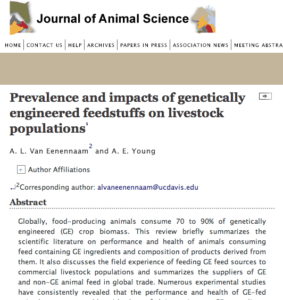 Just days ago came the publication of an unprecedented study that covers literally trillions of meals. Writing in the Journal of Animal Science, University of California-Davis geneticist Alison Van Eenennaam oversaw the longest term monitoring of the health impact of GM crops in history. She reviewed 29 years of feeding data covering more than 100 billion animals, from before 1996 when feed was 100 percent non-GMO, until after its introduction when it soared past 90 percent. She reviewed pre and post mortem records, as ill cattle cannot be approved for meat.
Just days ago came the publication of an unprecedented study that covers literally trillions of meals. Writing in the Journal of Animal Science, University of California-Davis geneticist Alison Van Eenennaam oversaw the longest term monitoring of the health impact of GM crops in history. She reviewed 29 years of feeding data covering more than 100 billion animals, from before 1996 when feed was 100 percent non-GMO, until after its introduction when it soared past 90 percent. She reviewed pre and post mortem records, as ill cattle cannot be approved for meat.
The study is unusual because of the vast trove of records examined. Van Eenennaam reviewed heath parameters including somatic cell count (SCC—an indicator of mastitis and inflammation in the udder) and pre and post mortem condemnation records in cattle, as ill cattle cannot be approved for meat, as well as mortality in the poultry industry. “It should be noted that if animals are sick they do not grow well, and growth rates have not be affected by GMO feed,” Van Eennaam told me.
The paper also summarizes the results of two thorough multigenerational studies that examined the long-term effects of feeding a GMO corn variety to food-producing animals, specifically, a German study in dairy cattle and an Irish study in pigs that included several papers looking specifically at health indicators. These studies were notable in that they included appropriate controls consuming isogenic non-GE lines of corn, and both comprehensively examined a range of phenotypes and indicators of health using sophisticated techniques including histopathology and hematological analyses. These papers found that that transgenerational consumption of these GMO corn diets was not detrimental to animal health.
It should be underscored that animal feeding studies are the basis for evaluating the safety of GMO crops; we do not do human studies on foods or drugs except for monitoring. The data also show that GM feed is safe and nutritionally equivalent to non-GMO feed. There was no evidence of any health risk to the animals and no evidence to suggest any health effect on humans who eat those animals.
There have been a few one-off outliers, such as the Seralini study, which was retracted and republished without peer review. But think about it: If his data were credible and 80 percent of food in the United States was poison, this Nobel Prize winning paper would not have had to be published in the Environmental Sciences Europe—an obscure ‘pay for play’ journal to which the French professor purchased access to. Good journals would not accept the tortured statistics, missing controls and over-interpretation of limited data.
You, this panel have an opportunity to end this charade, this faux debate over GMO safety: There are simply no credible studies in top flight journals—and none that has been repeated—that suggest serious likely safety issues that would not also apply to conventional or organic foods.
The scientific consensus does not mean the public embraces sound science on GMOs anymore than the certainty of natural selection closes the public debate over evolution. Polls indicate half of Americans believe in creationism or God-guided evolution. We see the same split between public opinion and science on the safety of vaccinations, on anthropogenic impacts on global warming—and with GMOs.
Existing GMO studies have been reviewed by nearly 100 of the world’s top independent organizations, including the NRC, and not one has concluded GMOs pose novel hazards. I’ve identified only two dissenting organizations: The American Academy of Environmental Medicine, which is not recognized by the board of Medical Specialties, is listed on the Quack Watch site, and, among other dubious beliefs, promotes the view that vaccines are dangerous.
And ENSSER—the European Network of Scientists for Social and Environmental Responsibility, founded by professor Seralini. Its deputy chair is a member of Seralini’s research team. Numerous GMO critics speaking at this meeting are members, including Seralini; Gurian-Sherman; Hansen; Benbrook and Janet Cotter of Greenpeace.
ENSSER is on record saying that many scientists at independent groups such as the World Health Organisation, European Food Safety Authority and the NRC—perhaps you—are shills—part of a global conspiracy of Monsanto, Big Ag and Big Chem; putting corporate profits ahead of consumer safety.
That’s just not responsible.
In recent months, many Academy members have expressed concern, even fury, about the low level of expertise of some of those invited. They could have invoked the words of Donald Kennedy, president emeritus of Stanford, former head of the FDA and distinguished member of the NAS. He has chided those “who give up the difficult task of finding out where the weight of scientific evidence lies, and instead attach equal value to each side in an effort to approximate fairness.” This results, he said, in “extraordinary opinions … promoted to a form of respectability that approaches equal status.”
If this meeting were being held at, say, the British Royal Society, I would wager many representatives from anti-GMO NGOs would not have been invited. Britain’s most senior scientist, president of the Royal Society Sir Paul Nurse, recently rebuked influential figures who he said distort science to support political, religious or ideological pre-conceived agendas. He was referencing in part, those who oppose transgenics in agriculture.
I don’t question the sincerity of the concerns of those invited about the future of food and farming any more than I would question the fervent belief of a Young Earth Christian that the earth is 6,000 years old. And I appreciate the bind that you faced in organizing this project. While not respected in the broader science community, some of those invited are part of the public conversation, just as creationists are part of the debate over evolution.
You face pressure to demonstrate to skeptics of GE that the NRC and by proxy the American people are listening to their concerns. Perhaps it made sense to invite science’s harshest critics. But panel members, don’t assume that those who will have spoken will ultimately embrace this process. Emboldened by the implicit endorsement that an appearance at the Academy confers, they will resume their campaigns to scare the public about a safe technology. Don’t be shocked that for years to come, they will make hay that they have been “consulted” by the National Academy of Sciences about GMOs. Don’t be surprised that when you issue your report in 2016, you will be ridiculed for holding what they will then characterize as a “rigged NRC process”.
That’s even more of a reason that if your goal is to demonstrate your leadership, it’s critical that you speak out about what the consensus science shows—no wavering or hedging to appease critics that fail to use good science. You may have to take a forceful and uncomfortable stand in the face of vocal criticism. Science is not a democracy. We don’t get to vote on whether a whale is a fish or a mammal.
As you move forward in this process, be wary of advocacy NGOs—organizations like the Center for Food Safety, Food and Water Watch, ETC Group, Union of Concerned Scientists and Consumers Union, among those represented here. They invariably present only one side of this complex issue.
Contrast that with the NGO that I founded three years ago—the Genetic Literacy Project. Its independent writers express their personal views—there is no “GLP editorial line” like you will find with the activist NGOs represented at this meetring. The GLP also daily aggregates a dozen published stories no matter what their ideological bent. Over the week before this meeting, for example, the GLP carried a report from Mother Jones criticizing biotech supporters who equate anti-GMOers with climate denialism; a defenseof Vandana Shiva’s critique of the Green Revolution; and a polemic claiming the overturning of Kauai’s anti-GMO law reflects the “corporate control” of our legal system.
The GLP is an NGO that believes that it has a responsibility to present a variety of viewpoints, even ones that I personally don’t agree with. That’s what journalists call “objectivity”. What we will not engage in is “false balance.”
False balance is a term in journalism that refers to presenting issues in which there is an overwhelming consensus in a way that makes it seem as if there are two fairly equal contrary viewpoints or two spokespeople of equal credibility. A cartoon about false balance illustrates this distressing phenomenon well.
A Larry King-like moderator of a two-person debate says: “So, we’ll be talking with Dr. Jenkins of the National Institute of Health about the result of his three-year study. And then for a different take, we’ll talk to Roger here, who I understand has reached the opposite conclusion by sitting on his couch and speculating.”
Biased journalists writing about GMOs often demonstrate false balance, such as a Reuters article by 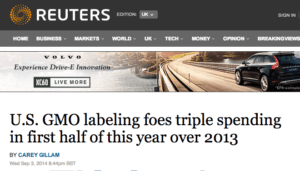 Carey Gillam on labeling that appeared two weeks ago:
Carey Gillam on labeling that appeared two weeks ago:
“Consumer groups and lawmakers pushing for mandatory labeling of GMOs say there is no scientific consensus on their safety…,” she wrote. “But the food and agriculture industries, including the makers of genetically modified corn, soybeans, canola … say their products are proven safe.”
Note how Gillam associates activists and conscientious legislators with protecting consumer safety while she makes it seem that Big Ag is the only defender of the safety of GMOs. Yet as we know, it’s not industry that has concluded that GMOs pose no unusual harm but every major independent global science organization. The Reuters article illustrates false balance—the lowest form of journalism.
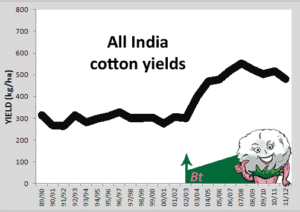 We all experienced an example of false balance in the September 15 presentation to the National Research panel by Glenn Stone, a sociocultural anthropologist at Washington University, St. Louis. He challenged claims that that the introduction of GM Bt cotton in India resulted in superior yields. The rise couldn’t have been from GMO crops, he told us, because only a fraction of India’s farmers were purchasing GM seeds when the yield rate began to soar in 2002. According to Stone, the India GM crops cause yield rise” is a post-modernist pro-GMO narrative. “Attribution of yield rises in Bt technology but trends fit adoption of Bt seeds poorly,” Stone concluded.
We all experienced an example of false balance in the September 15 presentation to the National Research panel by Glenn Stone, a sociocultural anthropologist at Washington University, St. Louis. He challenged claims that that the introduction of GM Bt cotton in India resulted in superior yields. The rise couldn’t have been from GMO crops, he told us, because only a fraction of India’s farmers were purchasing GM seeds when the yield rate began to soar in 2002. According to Stone, the India GM crops cause yield rise” is a post-modernist pro-GMO narrative. “Attribution of yield rises in Bt technology but trends fit adoption of Bt seeds poorly,” Stone concluded.
Simply said, Stone is wrong. He presented a chart of aggregate trends—not from a study mind you but from a news article—that is far too imprecise from which to draw any reasonable conclusions. However, data from actual farmers who switched from conventional to GM seeds and tracked their yields demonstrates conclusively that Bt crops do significantly bump yields.
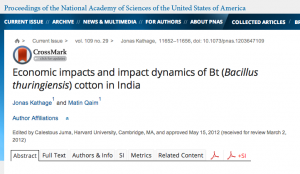 However, data from actual farmers who switched from conventional to GM seeds and tracked their yields demonstrates conclusively that Bt crops do significantly bump yields. A gold standard journal, The Proceedings of the National Academy of Sciences, published a study in 2012, highlighted inNature, post-dating Stone’s aging critique, documenting exactly that.
However, data from actual farmers who switched from conventional to GM seeds and tracked their yields demonstrates conclusively that Bt crops do significantly bump yields. A gold standard journal, The Proceedings of the National Academy of Sciences, published a study in 2012, highlighted inNature, post-dating Stone’s aging critique, documenting exactly that.
Two independent researchers with no conflicts of interest interviewed 533 farm households that switched from conventional to Bt cotton between 2002 and 2008. “The analysis showed,” they wrote, “that the yield of plots planted with Bt cotton increased by 24 percent compared with conventional cotton plots. This translated to a 50 percent increase in profits.”
There are a half-dozen similar studies (here, here, here,here), and all show the identical thing: Bt crops increase yields substantially while the use of insecticides plunges. It’s not that a key element of Stone’s perspective is not without merit—issues are grey and simplistic narratives are almost always wrong in part—but that he was creating his own narrative by not presenting to the panel the contextualized information. The presentation on Monday was not a case of false balance; it was selective presentation of data.
Increased yields are not limited to cotton. GE papaya has seen s 20-fold increase, for example. If you do not cherry-pick individual studies, but review multiple studies, every GM crop out yields conventional and organic competitors even though the current generation of GM crops was never specifically designed to increase yield.
 As the authors of the PNAS study note, “Civil society groups tend to emphasize potential risks of GM crops and question reports about positive agronomic and economic effects.” They specifically cite a 2009 polemic by Doug Gurian-Sherman, “Failure to Yield,” which appears on the website of the Union of Concerned Scientists, where he used to work. What you will not find at UCS, or on most advocacy NGO sites, is a summary or link to the PNAS study or dozens of others that directly contradict Gurian-Sherman’s ideological perspective.
As the authors of the PNAS study note, “Civil society groups tend to emphasize potential risks of GM crops and question reports about positive agronomic and economic effects.” They specifically cite a 2009 polemic by Doug Gurian-Sherman, “Failure to Yield,” which appears on the website of the Union of Concerned Scientists, where he used to work. What you will not find at UCS, or on most advocacy NGO sites, is a summary or link to the PNAS study or dozens of others that directly contradict Gurian-Sherman’s ideological perspective.
Anti-GMO NGOs are notorious for selectively presenting data. Consider claims made Monday by Charles Benbrook, a consultant for the organic industry, that GMOs are a “failure” and a “disaster”—those are his words. Why? In part, he says, because they’ve resulted in increased use of ag chemicals—a claim repeated as gospel on hundreds of websites. Such broad claims are misleading and contradicted by Benbrook’s own studies:
- Benbrook in his published research focuses on herbicide weight, not toxicity. The use of herbicide resistant GMOs has led to the substitution of far less toxic pesticides, particularly biodegradable and non-carcinogenic glyphosate, for chemicals known to cause harm to humans and beneficial insects.
- Bt crops have contributed to a dramatic drop in pesticide use—a 10-fold reduction in sprayed insecticides over the last 15 years according to the latest USDA report.
Many anti-GMO NGOs engage in sensationalism as a matter of course. I recently debated Hansen 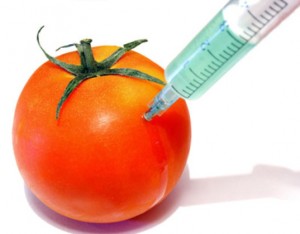
and noted that Consumer Reports, on its GMO page, features a tomato being shot up by a needle. Needless to say, there are no approved GM tomatoes and DNA is not injected into fruits with medical needles.
The most extreme example of this kind of demagoguery: Jeffrey Smith. He claims we are courting ecological and health catastrophe: GMOs cause autism, Alzheimer’s, Parkinson’s disease and obesity. The evidence? The rise in the incidences of those diseases vaguely correlates with GMO consumption—as does the increased consumption of organic foods. Does having a popular Internet following and appearances on Dr. Oz mean that this panel has to take this pseudo-science seriously? Notoriety should not be a substitute for good science.
The key challenge ahead for this panel: Will you resist the pressure from anti-GMO activists to legitimize their claims? Drawing a line down the 50-yard line and presenting with equal weight arguments from both sides is not only lazy journalism it is lazy science. That would be false balance.
Going forward, I urge you to focus on the many promising GM innovations that may never come to fruition if anti-GMO NGO views prevail: Golden Rice; nutrition-enhanced cassava; oranges, bananas, coffee beans, grapes and the like resistant to viruses or fungi; trees that can be rescued from near extinction, and dozens more cutting edge crops and plants. Will you leave innovations stillborn? If we don’t have all the tools available to combat global hunger—from organic farmers as well as from conventional agriculture—children will die.
I also hope you appreciate that your report will guide future regulation. Anti-GMO NGOs are urging you to tighten and lengthen the approval process. It’s already taken 17 years to run the regulatory gauntlet for a transgenic salmon that every US agency that has examined, has concluded is safe and nutritious, and it still remains unapproved. As Nina Fedoroff has written, “The three regulatory agencies need to coordinate a single set of requirements that focuses on the hazards presented by novel traits, not the method by which they were introduced. They need to accelerate the process, so that it takes months, not years, to get regulatory approval for a new crop modification. Above all, they need to stop regulating modifications for which there is no scientifically credible evidence of harm.”
The growth of the American economy depends upon innovation. Regulation that prevents The Next Big Thing is truly a lost opportunity—many once-touted biotech innovations have been killed in the crib by over-regulation: Triffid flax, Flvr Savr tomato, NewLeaf Potatoes and almost the entire field of transgenic animals. No longer can we expect breakthroughs in GE biorational pesticides, microorganisms to clean up toxic spills or transgenic animals.
Do we want to continue to thwart startups or university research projects? Or should we link science to regulatory sanity and revise the approval process to reflect what we’ve learned over decades of research and years of experience and trillions of meals?
And finally: Be bold. Bring public opinion along with you. It’s easy to scare people in the name of precaution; science sets a higher standard.
To summarize my presentation, I would make these points:
- DON’T LEGITIMIZE IDEOLOGY: Ground your report in reproducible findings. Distinguish between science and social views.
- INCLUDE SCIENTISTS IN THE TRENCHES: Seek a diversity of input that includes experts innovating novel traits, not just scientists who have spent a few years on a regulatory committee.
- INVOLVE FARMERS: Ask farmers why they use BT crops; it’s because they use less toxic inputs. Interview a GM papaya farmer, who might otherwise be working at a 7/11 if not for this technology.
- NO FALSE BALANCE: Call out selective presentation of viewpoints.
- FOCUS ON BIOTECH 2.0: Don’t just review existing crops, focus forward on innovations such as nutrition-enhanced and disease resistant crops that could whither if you fumble your charge.
- REVISE, STREAMLINE AND FAST TRACK REGULATION: Recognize this report will serve as a blueprint for legislation and oversight; the United States could squander biotech’s promise if the current regulatory framework remains in place or is larded with additional restriction.
Jon Entine, executive director of the Genetic Literacy Project, is a Senior Fellow, World Food Center, Institute for Food and Agricultural Literacy, University of California-Davis. Follow Jon on Twitter @JonEntine

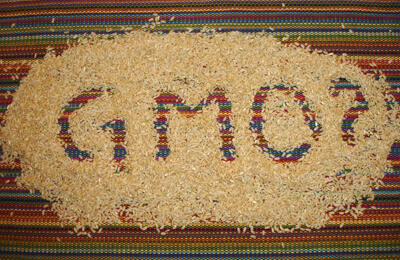

Outstanding, superb, off the charts! We can only hope they heed your advice, Jon.
Thank you Henry!
Thank you for very appropriate and strong statements.
An excellent article Jon.
However, you failed to dispel one particularly egregious myth being espoused by anti-GMO activists: the claim that GMOs pose some sort of threat to organic crops. As you know, this is not true. There is in fact no such thing as contamination of an organic crop by GMOs.
Still, a very solid piece!
Thanks for strongly articulating what so badly need to be said. Difficult situation for the panel. Since the majority of the panel are working scientists, I imagine that testimony from candidates like Jeffrey Smith or Seralini will have little impact. Perhaps the panel can use this time to call them out on some of their spectacular claims? As you suggest, the final report will almost certainly be blasted by groups supporting the Smiths and Seralinis. So calming the political waters initially is fruitless in the end.
Thank you for this. The whole “false balance” issue is just what these people needed to hear. Hopefully they will listen and take your advise.
This should be required reading for, well, just about everyone. A couple of comments.
Comparisons of GMO to anything is pointless because the term “GMO” is culturally defined, not scientifically defined. You’ve stated as much above and it is frustrating that we scientists doing research in this area (in my case environmental and human-health risk assessment of products produced from different agricultural technologies in an academic environment) have to constantly talk about the “product” rather than the “process” as the salient point. Then, we turn around and fall into the trap of comparing “GMOs” to other things because others with primarily a political agenda have dictated that we continue to treat “GMOs” as a thing to be evaluated for safety/acceptability rather than as merely a process to produce the product that of course should be evaluated as appropriate. This is especially frustrating because these activists have no interest in including gene mutation, tissue culture, and hybrid breeding processes, which at least would be more logically consistent.
“What about the claim made by Charles Benbrook and repeated endlessly by anti-GMO activists that there have been few or no long-term studies?” We can point to long-term studies and they are compelling, but what is often missing from this charge and response is that you shouldn’t do long-term studies of anything if there’s not a biologically plausible effect (e.g., mammalian toxicity to Bt proteins). What exactly are we measuring? We know that if we haven’t identified a potential deleterious or beneficial effect, statistical noise will generate a statistically significant, though not biologically significant, result. This is often what we see with low-dose epidemiological studies.
Furthermore Bob, the idea that one would need more than 90 days to see a putatively hormonal or soft tissue pathology is absurd. At the doses tested, these effects would manifest pretty quickly at the cellular level, but typically we don’t sacrifice the animals at shorter intervals than the end of the study. Complaints about lack of “long-term” studies are smoke blowing exercises to ignore basic physiological principles and ignore biochemical kinetics.
Well done Jon. An excellent presentation that highlights exactly what is going on.
Thanks Robert!
JON
Honest and hard hitting. Great job. Hope the committee heeds your advice!
Incredibly well written argument, Jon. What a shame that the beauty of one of Mother Nature’s mechanisms for propelling evolution, namely horizontal gene transfer, cannot be appreciated by certain folks who cling to the naturalistic fallacy. Genome biology shows us that 50-60% of Prokaryotes have acquired genes across species and higher taxonomic boundaries via horizontal gene transfer. About 10% of Eukaryotes have “experienced” horizontal gene transfer in their past evolutionary trajectories across Kingdoms (and even Domains). My favorite recent story is the aphids who have acquired functional carotenoid synthesis genes from symbiotic fungi and turn orange when alarmed. Without the discovery of Agrobacterium tumefasciens’ amazing tricks of horizontal gene transfer, where would the biotech industry have been today? Over 300,000 GOOGLE Scholar hits on the search string “horizontal gene transfer” tells me that genetic engineering or transgenic breeding or whatever you want to call it is as natural as motherhood and apple pie, made with ArcticTM non-browning apples bred by Okanagan Specialty Fruits.
The confusion is over poison added to the seeds of GMO. For scientist to overlook this obvious concern is reason enough for me to not trust GMO’s no matter how you spin it.
Please clarify “poison added to the seeds of GMO”. What poison are you talking about and which seeds?
And please explain what you mean by “overlook”. If you are referring to bt, readers of this site are well aware of lots of evaluation of the bt protein as it exist in nature and as expressed in plants for human safety. It has hardly been overlooked.
So, we’re just speeding up nature when we engineer bacterial toxins into corn to kill insects that eat it? And engineer the growth of salmon, along with their reproductive capabilities?
Hmm.
Seems like people support “natural” when they want to promote transgenics as being natural, but then claim that some are following the “natural fallacy” when they want to belittle concerns.
What part of “science trumps ideology” do people not get?
Very good points against the pseudoscience. I shall use these arguments in my class to educate my students on how take on pseudoscience!
Your poor, poor students! I feel sorry for them.
Very well put. I don’t see how the NRC could ignore a solid and compelling base of quality evidence that the process of genetic engineering itself does not appear to introduce heightened or novel risks for the safety and quality of food products derived from organisms having one or more traits facilitated by ge methods. (note-I avoided using the term GMO). That does not discard that there are, perhaps, legitimate scientific questions and legitimately held (I distinquish between legitimately held and legitimate) doubts by the lay public. It is not necessarily irrational to ask the question; “Does the process of splicing DNA and introducing new information have the potential to cause unintended or undetected damage throughout the genome, and if so could these have implications that compromise food safety or quality? Can we rule out that there is not some as yet undiscovered law of nature that would result in a risk such tinkering outside of evolved forms of genetic transfer could be chaotic or unpleasant?
These are fair questions, but not unfathomable and mystical uncertainties and something science does not or cannot comprehend. The gulf between the gmo skeptic community, and those who turn to them for information, and the mainstream scientific community is that the former ignores the considerable efforts to examine those very questions from a variety of angles. They then tend to represent these questions as something science has not thought to explore or swept under the rug, and that it is self evident that commercial players have an interest in suppressing public knowledge or concern about these questions. When the public reads Earth Open Source, it is effective because the public believes that research described and interpreted (badly) there is the first and only of its kind. Very seldom is the public given the broader context in which this selected research is found. To the extent that NRC frames accusations and fears about the technology into appropriate questions like these and shows that the scientific and even commercial communities have engaged in considerable inquiry, the more that could be reassuring to the public.
I suspect that a major focus of the NRC assessment will lie more in the realm of how wisely and effectively has this technology been applied. Therein lies where I believe the battle lines are actually ultimately drawn. Even if the question about the safety of the process is settled, there can be legitimately held questions about whether certain applications have actually improved the world, whether they in some cases preclude or substitute for less technologically intense means to address agronomic problems and promote sound stewardship that might have worked better or avoided unintended consequences. There are empirical approaches to inform the answers to these questions but this realm has an element of philosophy, one that invokes values and cultural ideals as much as scientific truth. I think Steve Savage does a good job at Applied Mythology to put ge in the proper context, what is the specific agronomic issue, what conventional/organic approaches are available, how well have they worked and how compatible they are with cultural expectation, and how would ge overcome shortcomings. I hope NRC can provide that type of context.
I said, “These are fair questions, but not unfathomable and mystical uncertainties and something science does not or cannot comprehend.”
That should read, “These are fair questions, but not unfathomable and mystical uncertainties, and NOT something science does not or cannot comprehend.”
Great article Jon! I particularly appreciated the following:
“I’m going to use the term “GMO” in this talk but want to make an important point:
‘Genetically modified organism’ is a meaningless term. GM is a process. Each GM crop is unique. You cannot group nutritionally enhanced Golden Rice with herbicide tolerant corn: Different crop, different trait, different consumer.”
In my opinion, you could even have stopped there! I’m writing an entire book to demolish the bogus category, the gigantic blunder. Also Henry Miller tried to: http://www.forbes.com/sites/henrymiller/2014/07/09/genetic-engineering-is-a-tool-not-a-category-stupid/
Greetings from Lombardy, Italy!
Thank you, appreciate that!
I am actually increasingly pleased that the NAS folks let these folks talk, because I am enjoying seeing them hoisted on their own petards.
Jeff Smith presented flat-out fiction to these scientists. https://twitter.com/mem_somerville/status/512227716872302592
Seems to me it’s very helpful to have someone destroy their own credibility.
Really great Jon. Best thing I’ve read in a long time. Let’s hope they have the courage to follow this guidance.
How far up Jon’s arse can you get Kevin?
Good question!
Thank you for the great article. I am posting the link to our local Ag Society who have collectively taken a pseudo-religious stance against GE/GMO. Most will not read it, but perhaps even one will.
Jon,
I wanted to compliment you on this article (and the website as a whole). Both are very professional, informative, and convincing.
I’ve definitely had to reexamine some of my long-held beliefs in the light of the information presented here. Thank you.
One quibble with this presentation: I know it wasn’t the point of the NAS meeting, but I started having doubts about your argument where you say “There exists a range of viewpoints about whether genetic engineering promotes deleterious farming and ecological practices…Those are important issues; they just don’t apply specifically to GMOs.”
I think many issues do apply specifically or especially to GMOs. And I can’t in good faith compartmentalize “ecology” from “human health”. The idea that the agroecology of these crops is irrelevant to their wide-scale approval might trip up other people, too.
The propagandist doth protest too much, Jon. What do you have to fear from an objective look at both sides of the coin? I know. It’s that your castle of lies will soon be turned to sand and the world will no longer be content to whistle past the graveyard. I’ll just leave this here:
http://www.propagandists.org/propagandists/jon-entine/
http://gmofreeusa.org/gmos-are-top/gmo-science-studies/
Dear NAS,
I’m not a scientist, but I play one on the web :)
There is a repetition of a paragraph about U. of California-Davis geneticist Alison Van Eenennaam’s study towards the beginning of the article.